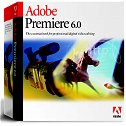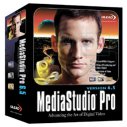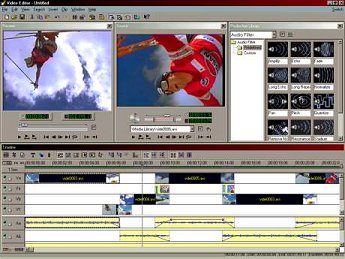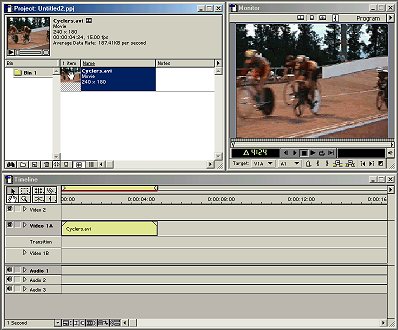Manifest Technology Blog
-- Site:
| Articles
| Galleries
| Resources
| DVI Tech
| About
| Site Map
|
Articles:
| PC Video
| Web Media
| DVD & CD
| Portable Media
| Digital Imaging
| Wireless Media
| Home Media
| Tech & Society
|
PC Video: |
PC Video Articles |
Video Software Gallery |
Video Editing Resources |
Professional Video Editing Alternatives:
Adobe Premiere 6 and
Ulead Media Studio Pro 6.5 (4/2002)
by Douglas Dixon
Ulead Media Studio Pro 6.5
Adobe Premiere 6
Your Choice
As you get more experienced with video editing, you may want to step up to a
more professional editing tool, such as Adobe Premiere 6 or Ulead Media Studio
Pro 6.5. These not only offer more capability and headroom in terms of editing
features, but also provide a more comfortable, robust, and customizable
environment for getting serious with video.


Both Premiere and Media Studio Pro are mature applications that have evolved
to provide the same general capabilities. However, they are significantly
different in their design philosophy. Like other Adobe tools, Premiere is a
tightly integrated editing environment designed to match the working style of
professional editors. In the Ulead style, Media Studio Pro, is a suite of five
more loosely integrated tools that can provide a broader range of features.
Ulead Media Studio Pro 6.5 ($495 list, www.ulead.com),
released in August 2001, added advanced features including DV scene detection,
MPEG-2 editing, and even DVD authoring. Many of these were first introduced in
Ulead's consumer applications, which tend to evolve faster, and provide the
opportunity to break in new technology.

The first Media Studio Pro application, Video Capture, captures clips from
the usual analog or DV sources. Premiere uses a Capture dialog window within the
main application, so you can manage the project settings end-to-end. Media
Studio Pro adds support for DV capture beyond the 4 GB Windows limit, direct
capture to MPEG-1 or MPEG-2, DV scene detection, and helpful Vectorscope and
Waveform monitors for color calibration.
The core Media Studio Pro application is Video Editor, with the basics
including a Production Library to organize assets, an optional Storyboard to
arrange clips, and a multi-track Timeline where you edit the production. Other
useful features include native MPEG editing, instant playback from the Timeline,
and batch rendering of multiple projects.
Media Studio Pro then provides three integrated applications in which you can
prepare clips, without needing to render. The Audio Editor lets you mix, adjust,
and apply filters to audio clips. CG Infinity generates vector-based motion
graphics for animated titles and video overlays. And Video Paint is for
rotoscoping (or painting) effects directly over video frames, including assists
for animating effects over motion video, and recording painting sequences as
reusable macros.
Adobe Premiere 6 ($549 list, www.adobe.com),
released in December 2000 (with a 6.1 upgrade in June 2001), brought important
new features such as DV capture and Web video output. It also added significant
usability enhancements to make it quite accessible for non-professional users.
These included a storyboard organizer, palette windows used to organize filters
and effects, and a powerful history capability to selectively undo and redo
editing operations.

Premiere provides a single environment that is focused on optimizing the
editing process. It supports predefined and customized workspace layouts for
different editing needs, and single-press keyboard shortcuts. It also provides
precise control of editing tracks in the timeline.
You can edit audio clips directly on the Timeline and apply audio effects in
the same way as video effects. Premiere also has a powerful Audio Mixer to
combine and adjust all audio tracks simultaneously.
Premiere is integrated with Adobe's suite of tools for graphics and media
professionals, and shares a common interface design. Although the program has a
relatively simple Title window for formatting text and graphics for use as
titles, you also can import material from Illustrator and Photoshop, complete
with alpha channel mattes, and even edit the original content after importing.
Similarly, you can animate overlay tracks directly in Premiere using the Motion
Settings dialog, or export to After Effects for advanced compositing, animation,
and visual effects.
Premiere has an impressive heritage as the market-leading professional video
editing software package, on both Windows and Macintosh platforms. The benefits
of its popularity include the large number of resources available for it,
including books, training courses, user groups, and on-line discussion groups.
Premiere is also bundled with a wide array of video capture and real-time
editing hardware, providing a variety of upgrade paths to more power.
Finally, both Premiere 6 and Media Studio Pro 6.5 can export productions in a
wide variety of desktop and Web video and audio formats. Premiere includes a
bundled version of Discreet Media Cleaner for additional formats, and can export
Web markers and links.
Media Studio Pro provides the DVD Authoring module, a template-driven tool
for creating productions on DVD, VCD, or SVCD. You mark scenes in your video
production, select a menu design template, preview the navigation, and then
output.
Since Premiere 6 and Media Studio Pro 6.5 have such different approaches to
video editing, the choice between them really depends on your preferred working
style, each program's interoperability with other digital media tools, and your
needs for specific unique features.
As an example of this difference in style, while Premiere carefully organizes
project, system, and device options in logical Settings dialogs, Ulead takes a
much more open approach to exposing the innards of your system. Many dialogs
offer a "Properties" button that will display all kinds of fascinating
nitty-gritty information and options. This access to the internals alone can
make Media Studio Pro a requirement for inquisitive users.
Choose Premiere 6 for its tight integration with other Adobe tools, and for
its careful attention to optimizing the editing process, with a refined
interface and customizable workspace.
Choose Media Studio Pro 6.5 for a more component-based approach to the
editing process, and access to newer technology such as MPEG-2 and DVD.
You can download trial versions of both products to experiment with them,
although they require rather large downloads (at least 50 MB).
If you also need an IEEE 1394 / DV capture board, you can save money by
buying a board bundled with Premiere or Media Studio Pro. Products like the ADS
Technologies Pyro DV line offer a 1394 card with a full version of Premiere or
Media Studio Pro for around $280, or less than the street price of the software
alone (www.adstech.com). Adobe also offers the Digital Video Collection bundle,
with Photoshop, Illustrator, Premiere, and After Effects for $1199 (street).
Adobe Premiere 6
www.adobe.com
Ulead Media Studio Pro 6.5
www.ulead.com
(Originally published in PC Magazine.)
|
